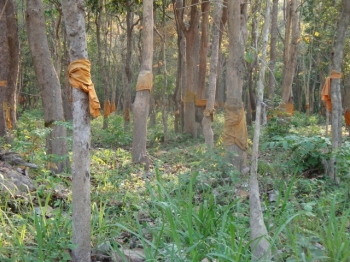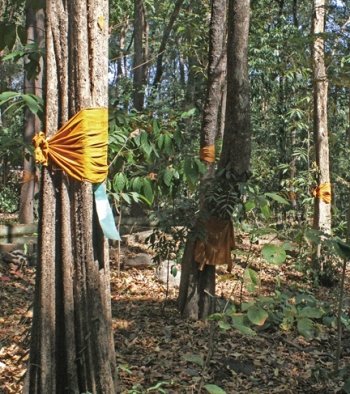It is easy to overlook the power and weight that symbolic gestures offer. They do not attract as much attention as a large demonstration or a nude body in public. Most symbolic gestures are innocuous, everyday deeds like a kiss on the forehead, visiting a pilgrim’s grave on one’s birthday, or a certain Jewish rabbi washing his disciples’ feet. Sometimes, their meaning needs to be interpreted and understood before we can fully appreciate their magnitude. The authority of symbolic gestures lies not in their frequency or volume, but in the context and identities of the involved agents.
The touching of the earth by Siddhartha Gautama was an otherwise unremarkable act of mind and body. This deed and the bhumi-sparsha mean nothing on their own. However, Gautama touched the earth specifically in response to Mara’s challenge that he had no witness to prove his worthiness. Gautama's act indicated that it was only the Earth, or the earth goddess, Prithvi, that had the authority to testify to Gautama’s right to sit on the Diamond Throne.
Tying saffron fabric around trees evokes a similar power. Susan Darlington's excellent monograph The Ordination of a Tree: The Thai Buddhist Environmental Movement highlighted how ordaining a tree by bestowing it the cloth of the sangha was intended to imbue it with the same respect accorded to monks in Thai society. For if even the King of Thailand must bow in the presence of monastics, then according trees the clerical identity affirms not only their holiness in the ecological sense, but also in the social and religious sense. It is symbolically poignant because for Thais, monastic service is the highest calling. To have (human) monks bestow the Buddha's transmission on trees is to make a splendid statement about the critical role of trees in our world. It also means that to harm trees and forests in the way modern machines do is to effectively murder a community of monks. It is difficult to think of a more dramatic symbolism.
In the past, canonical Theravada has been ambiguous about ecological ideas, especially the notion of flora having the same importance as sentient beings like animals and humans (although there are stories of monks and nuns protecting the spirits that live in trees). But the broadening of the definition of sentience itself was well underway in East Asia by the time Buddhism had suffused Chinese culture (and by extension, countries in China’s cultural and political orbit). Ch’an masters were discussing the Buddha-nature of rocks, trees, and waterfalls long before Joanna Macy, a pioneer of eco-Buddhism, argued that orthodox Buddhist teachings support environmental care.
The Chinese sages and painters captured the Buddhist teachings best when their ink marked entire landscapes of soaring mountain and lush forest as sacrosanct. The black ink that immortalizes China's ecological wonders wields the same symbolic weight as the saffron robes wrapped around the trunks of Thai trees - blessing and affirming the pillars of the earth.
















